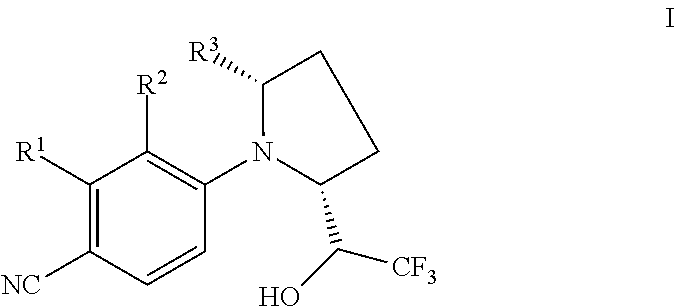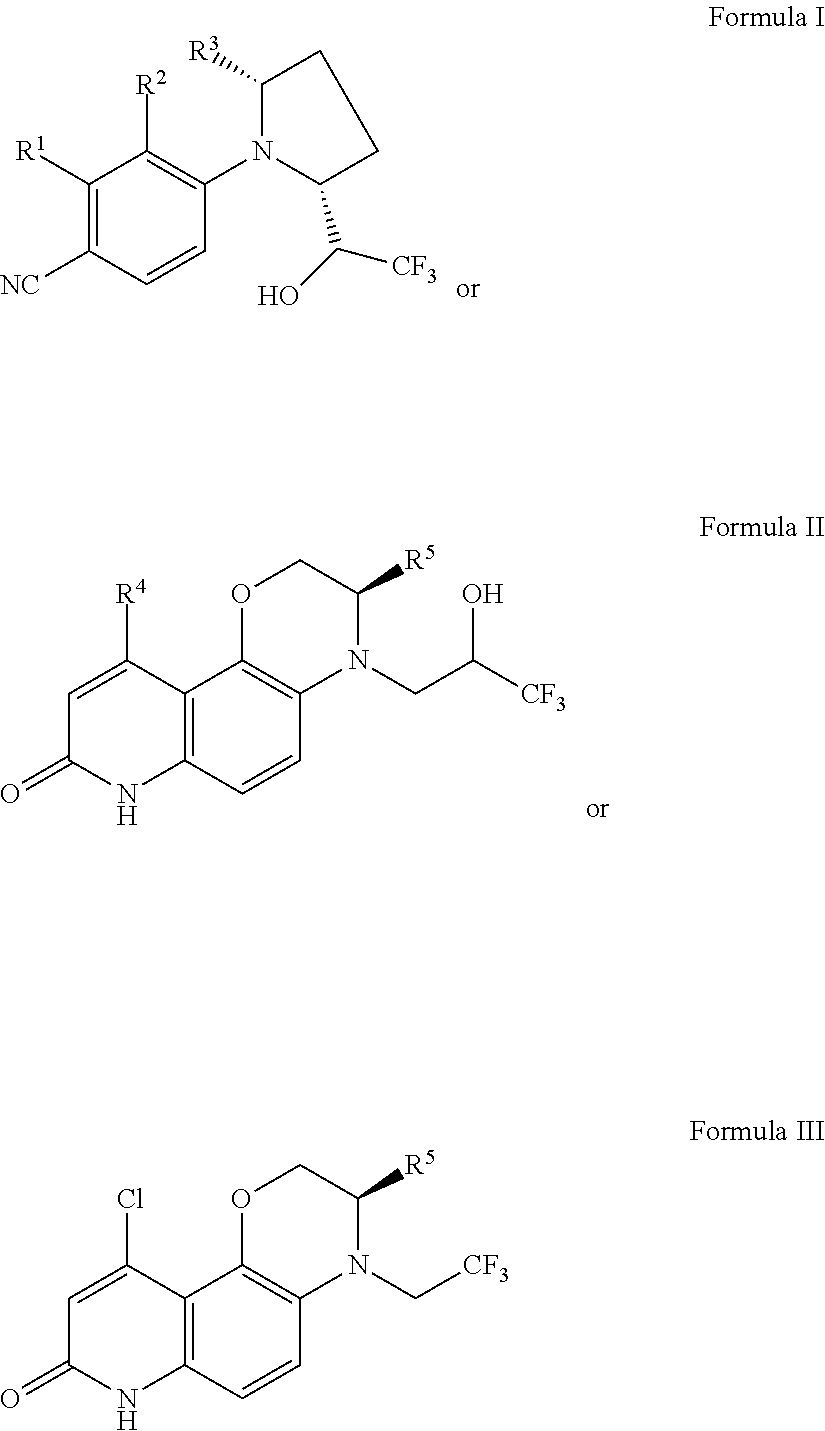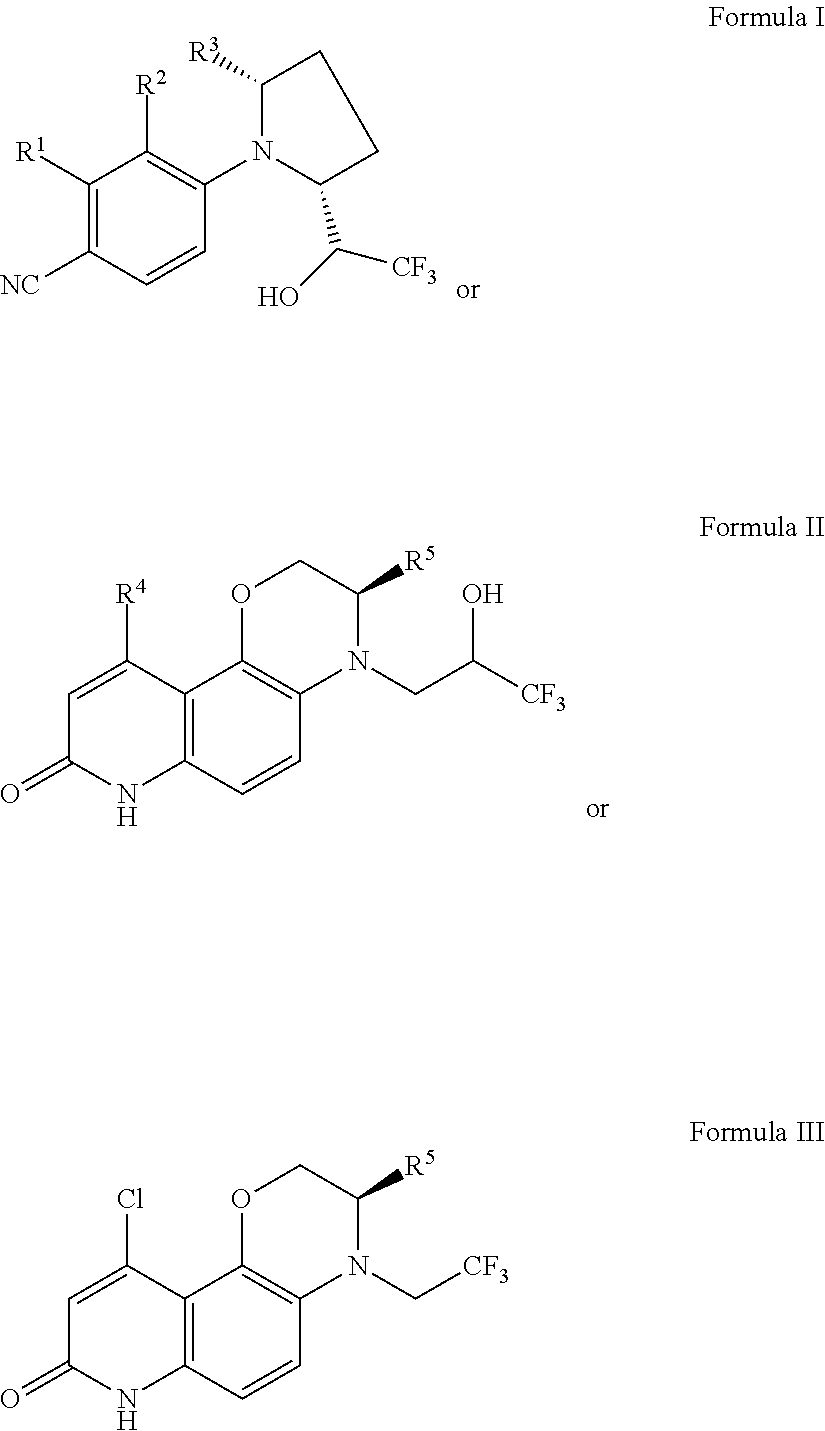Selective androgen receptor modulators (SARMs) and uses thereof
a selective androgen receptor and modulator technology, applied in the field of selective androgen receptor modulators, can solve the problems of modulators of steroid receptors, modulators of transcriptional activation, acne, etc., and achieve the effects of reducing the risk of prostate cancer
- Summary
- Abstract
- Description
- Claims
- Application Information
AI Technical Summary
Benefits of technology
Problems solved by technology
Method used
Image
Examples
example 1
[0617]
4-(2(R)-(1(S)-hydroxyl-2,2,2-trifluoroethyl)-pyrrolidinyl)-2-trifluoromethyl-benzonitrile (Compound 101) and R,R-4-(2-(1-Hydroxyl-2,2,2-trifluoroethyl)-pyrrolidinyl)-2-trifluoromethyl-benzonitrile (Compound 102)
[0618]A mixture of D-prolinol, 4-fluoro-2-trifluoromethylbenzonitrile, and triethylamine in THF was stirred over night at 60° C. Standard work-up of the reaction mixture provided R-4-(2-hydroxylmethylpyrrolidinyl)-2-trifluoromethyl-benzonitrile in moderate yield. The intermediate alcohol was oxidized by sulfur trioxide pyridine complex to give R-4-(2-formyl-pyrrolidinyl)-2-trifluoromethyl-benzonitrile. The aldehyde intermediate was treated with trimethyl(trifluoromethyl)-silane to provide a mixture of two diastereomers. HPLC separation generated pure forms of Compounds 101 and 102.
[0619]Compound 101: 1H-NMR (500 MHz, CDCl3) 7.59 (d, J=8.8, 1H), 7.07 (d, J=2.9, 1H), 6.92 (dd, J=8.8 and 2.9, 1H), 4.24 (t, J=7.5, 1H), 3.91 (t, J=6.3, 1H), 3.63 (dd, J=7.8 and 9.3, 1H), 3.29...
example 2
[0621]
R, R, R-4-(2-(1-Hydroxyl-2,2,2-trifluoro ethyl)-5-methylpyrrolidinyl)-2-trifluoromethylbenzonitrile (Compound 103) and 4-(2(R)-(1(S)-hydroxyl-2,2,2-trifluoroethyl)-5(R)-methylpyrrolidinyl)-2-trifluoromethylbenzonitrile (Compound 104)
[0622]Compounds 103 and 104 can be prepared in a similar fashion as described in Example 1 by using D-pyroglutamic acid as a starting material.
[0623]Compound 103: 1H-NMR (500 MHz, CDCl3) 7.54 (d, 1H, J=8.5), 6.88 (d, 1H, J=2.3), 6.68 (dd, 1H, J=8.5 and 2.3), 4.41-4.32 (m, 1H), 4.19-4.15 (m, 1H), 3.98-3.93 (m, 1H), 2.79 (d, 1H, J=5.6), 2.59-2.49 (m, 1H), 2.17-1.98 (m, 2H), 1.93-1.85 (m, 1H), 1.35 (d, 3H, J=6.1).
[0624]Compound 104: 1H-NMR (500 MHz, CDCl3) 7.62 (d, 1H, J=8.8), 7.16 (d, 1H, J=2.3), 6.99 (dd, 1H, J=8.8 and 2.3), 4.21-4.15 (m, 1H), 3.95-3.84 (m, 2H), 2.60 (d, 1H, J=3.5), 2.43-2.34 (m, 1H), 2.04-1.99 (m, 2H), 1.94-1.72 (m, 1H), 1.40 (d, 3H, J=6.1).
example 3
[0625]
R,R-4-(2-(1-Hydroxyl-2,2,2-trifluoroethyl)pyrrolidinyl)-2-chlorobenzonitrile (Compound 105) and 4-(2(R)-(1(S)-hydroxyl-2,2,2-trifluoroethyl)pyrrolidinyl)-2-chlorobenzonitrile (Compound 106)
[0626]Compounds 105 and 106 can be prepared in a similar fashion as described in Example 1 by using 2-chloro-4-fluorobenzonitrile as a starting material.
PUM
 Login to View More
Login to View More Abstract
Description
Claims
Application Information
 Login to View More
Login to View More - R&D
- Intellectual Property
- Life Sciences
- Materials
- Tech Scout
- Unparalleled Data Quality
- Higher Quality Content
- 60% Fewer Hallucinations
Browse by: Latest US Patents, China's latest patents, Technical Efficacy Thesaurus, Application Domain, Technology Topic, Popular Technical Reports.
© 2025 PatSnap. All rights reserved.Legal|Privacy policy|Modern Slavery Act Transparency Statement|Sitemap|About US| Contact US: help@patsnap.com



